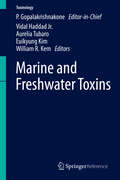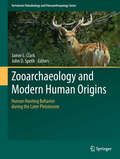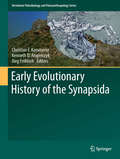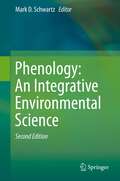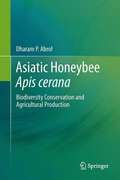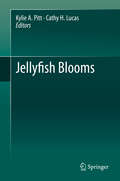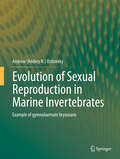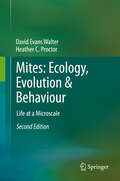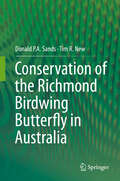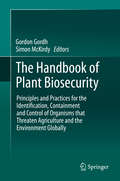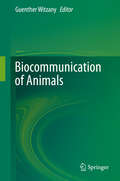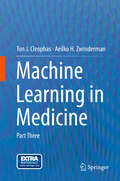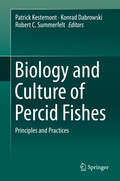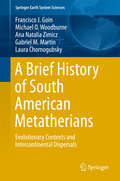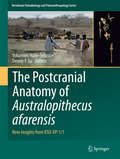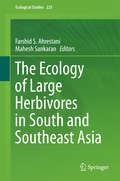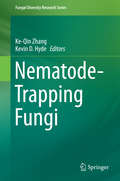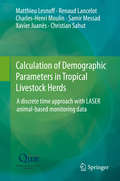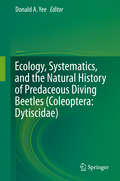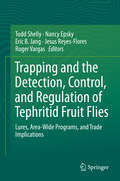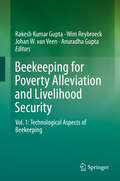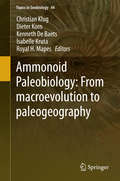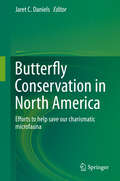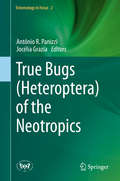- Table View
- List View
Marine and Freshwater Toxins
by P. Gopalakrishnakone Vidal Haddad Jr. Aurelia Tubaro Euikyung Kim William R. KemThis book presents the structure of the main toxins of aquatic origin, their distribution, producing species and vectors, their mechanisms of action, the clinical aspects of envenomation in humans, their effects in laboratory or wild animals, their toxicokinetic properties, including the relevant treatment, detection methods and regulatory aspects for management. The work also presents the main species associated with the injuries, poisonings their toxins, mechanism of action and the clinical aspects of the envenomations by aquatic animals and discusses the actual measures utilized in the first aid and hospital treatments. Marine toxins such as palytoxins, brevetoxins, saxitoxin, ciguatoxins, okadaic acid, azaspiracid toxins, equinatoxins are also dealt with in this volume. These toxins can be lethal as well as having a complex and large molecular structure and display mechanisms by which they act very specifically on targets, receptors or on critical body proteins. The marine and freshwater environments are the new frontiers of humanity, but the increase of economic and tourist activities provoke nasty encounters between aquatic animals and humans. The main victims are swimmers, professional and sportive fishermen, surfers and scuba divers as well as people working in related fields. The identification, knowledge and treatment of envenomations caused by venomous and poisonous animals are not adequate and the prevention of injuries still is not possible. Additionally, the immense potential of the pharmacologic effects of their toxins is not fully explored. Toxins of venomous aquatic animals can cause proteolysis, myotoxicity, hemotoxicity (mainly hemolysis), cytotoxicity and neurotoxicity. The neurotoxicity is generally associated with toxins of dinoflagellates and cyanobacteria, present in poisonous and/or contaminated invertebrates and fish.
Human Happiness and the Pursuit of Maximization: Is More Always Better?
by Hilke Brockmann Jan DelheyThis book tests the critical potential of happiness research to evaluate contemporary high-performance societies. These societies, defined as affluent capitalist societies, emphasize competition and success both institutionally and culturally. Growing affluence improves life in many ways, for a large number of people. We lead longer, safer, and more comfortable lives than previous generations. But we also live faster, and are competition-toughened, like top athletes. As a result, we suspect limits and detect downsides of our high-speed lives. The ubiquitous maximization principle opens up a systematic gateway to the pleasures and pains of contemporary life. Using happiness as a reference point, this book explores the philosophical and empirical limits of the maximization rule. It considers the answer to questions such as: Precisely, why did the idea of (economic) maximization gain so much ground in our Western way of thinking? When, and in which life domains, does maximization work, when does it fail? When do qualities and when do quantities matter? Does maximization yield a different (un)happiness dividend in different species, cultures, and societies?
Zooarchaeology and Modern Human Origins: Human Hunting Behavior during the Later Pleistocene
by Jamie L. Clark John D. SpethRecent genetic data showing that Neanderthals interbred with modern humans have made it clear that deeper insight into the behavioral differences between these populations will be critical to understanding the rapid spread of modern humans and the demise of the Neanderthals. This volume, which brings together scholars who have worked with faunal assemblages from Europe, the Near East, and Africa, makes an important contribution to our broader understanding of Neanderthal extinction and modern human origins through its focus on variability in human hunting behavior between 70-25,000 years ago--a critical period in the later evolution of our species.
Early Evolutionary History of the Synapsida
by Christian F. Kammerer Kenneth D. Angielczyk Jörg FröbischNon-mammalian synapsids were the dominant terrestrial vertebrates from the Late Carboniferous to the Middle Triassic and play a key role in understanding the origin and evolution of mammals. Despite these facts and the outstanding fossil record of the group, early synapsids remain obscure. This book showcases the full breadth of contemporary research on non-mammalian synapsids, ranging from taxonomy and phylogenetics to functional morphology, biogeography, paleoecology, and patterns of diversity. It also underscores the importance and potential of studying non-mammalian synapsid paleobiology in its own right, not just in the context of mammalian evolution.
Phenology: An Integrative Environmental Science
by Mark D. SchwartzPhenology refers to recurring plant and animal life cycle stages, such as leafing and flowering, maturation of agricultural plants, emergence of insects, and migration of birds. It is also the study of these recurring events, especially their timing and relationships with weather and climate. Phenological phenomena all give a ready measure of the environment as viewed by the associated organism, and are thus ideal indicators of the impact of local and global changes in weather and climate on the earth's biosphere. Assessing our changing world is a complex task that requires close cooperation from experts in biology, climatology, ecology, geography, oceanography, remote sensing, and other areas. Like its predecessor, this second edition of Phenology is a synthesis of current phenological knowledge, designed as a primer on the field for global change and general scientists, students, and interested members of the public. With updated and new contributions from over fifty phenological experts, covering data collection, current research, methods, and applications, it demonstrates the accomplishments, progress over the last decade, and future potential of phenology as an integrative environmental science.
Asiatic Honeybee Apis cerana: Biodiversity Conservation and Agricultural Production
by Dharam P. AbrolDespite its economic usefulness, biodiversity of Asian hive bee Apis cerana is suffering precipitous decline and is threatened with extinction in its entire native habitat. Although a number of publications have appeared on honeybees in the market no attempt has been made to approach the subject in systematically and in a comprehensive manner in case of Apis cerana. There is still not enough knowledge on different facets of biological conservation, agricultural production and role in improving food security and livelihoods. An attempt has been made in this book to fill the gap by providing detailed information on different aspects of Apis cerana leading to sustainability and environmental protection. This book discusses information on varied aspects of Apis cerana biology, biogeography, reproduction, genetics, molecular phylogeny, interaction with other species, floral resources, dance language, safety from pesticides, management problems, loss of genetic diversity, behavioural defence, role in food production, livelihood security and conservation strategies for protecting biodiversity and enhancing crop productivity. The compilation of this book is unique in the sense that in the context of pollinator decline over the world, conservation of this species will be a step for sustaining food security.
Jellyfish Blooms
by Kylie A. Pitt Cathy H. LucasJellyfish are one of the most conspicuous animals in our oceans and are renowned for their propensity to form spectacular blooms. The unique features of the biology and ecology of jellyfish that enable them to bloom also make them successful invasive species and, in a few places around the world, jellyfish have become problematic. As man increasingly populates the world's coastlines, interactions between humans and jellyfish are rising, often to the detriment of coastal-based industries such as tourism, fishing and power generation. However we must not lose sight of the fact that jellyfish have been forming blooms in the oceans for at least 500 million years, and are an essential component of normal, healthy ocean ecosystems. Here many of the world's leading jellyfish experts explore the science behind jellyfish blooms. We examine the unique features of jellyfish biology and ecology that cause populations to 'bloom and bust', and, using case studies, we show why jellyfish are important to coastal and ocean ecosystem function. We outline strategies coastal managers can use to mitigate the effects of blooms on coastal industries thereby enabling humans to coexist with these fascinating creatures. Finally we highlight how jellyfish benefit society; providing us with food and one of the most biomedically-important compounds discovered in the 20th century.
Evolution of Sexual Reproduction in Marine Invertebrates
by Andrew Andrey N. OstrovskyThree major aspects that distinguish this book are that (1) it contains the most detailed analysis of the sexual reproduction (oogenesis, fertilization and embryonic incubation) in a particular phylum of the aquatic invertebrates (Bryozoa) ever made; this analysis is based on an exhaustive review of the literature on that topic published over the last 260 years, as well as extensive original histological, anatomical and morphological data obtained during studies of both extant and extinct species; (2) this broad analysis has made it possible to reconstruct the major patterns, stages and trends in the evolution of sexual reproduction in various bryozoan clades, showing numerous examples of parallelisms during transitions from broadcasting to embryonic incubation, from planktotrophic to non-feeding larvae and from lecithotrophy to placentation; corresponding shifts in oogenesis, fertilization and embryonic development are discussed in detail; and (3) the key evolutionary novelties acquired by Bryozoa are compared with similar innovations that have evolved in other groups of marine invertebrates, showing the general trends in the evolution of their sexual reproduction. Ecological background of these innovations is considered too. Altogether these aspects make the monograph an "Encyclopedia of bryozoan sexual reproduction," offering an integral picture of the evolution of this complex phenomenon.
Mites: Ecology, Evolution & Behaviour
by David Evans Walter Heather C. ProctorThere are over 40 000 named species of mite, and if estimates for unnamed species are included, then up to 1 million may grace the planet. By comparison, there are approximately 40 000 species of vertebrates, half of them fish, alive today. Mites are predators, parasites, herbivores and detritivores. They live in the dark depths of the ocean, in the lungs of birds, on the leaves of rainforest plants, and in human clothes and bedding. They are vectors of disease, vital players in soil formation, and important agents of biological control. Despite the grand diversity of mites, these small arthropods are often overlooked, and even trained biologists can be unaware of their significance. This books aims to fill the gap in our understanding of these intriguing creatures. It surveys life cycles, feeding behaviour, reproductive biology and host-associations of mites, without requiring prior knowledge of their morphology or taxonomy. The text is richly illustrated with line drawings and photographs. Topics covered include evolution of mites and other arachnids, mites in soil and water, mites on plants and animals, sperm transfer and reproduction, and mites as models of ecological and evolutionary theories.
Conservation of the Richmond Birdwing Butterfly in Australia
by Tim R. New Donald P.A. SandsThis survey of one the longest insect conservation campaigns in Australia deals with recovery of one of the most iconic endemic butterflies, the Richmond birdwing, threatened by clearance and fragmentation of subtropical rainforest in eastern Australia and the spread of an alien larval food-plant. Its conservation has involved many aspects of community involvement, developed over more than 20 years, and focused on habitat restoration and weed eradication, in conjunction with conservation of remaining forest fragments. The work has involved the entire historical range of the butterfly, addressed threats and emphasised landscape connectivity, and has enhanced recovery through extensive plantings of native food plants. Interest has been maintained through extensive publicity, community education and media activity, and the programme has provided many lessons for advancing insect conservation practice in the region.
The Handbook of Plant Biosecurity
by Gordon Gordh Simon MckirdyThe Handbook identifies all aspects of Regulatory Plant Biosecurity and discusses them from the standpoint of preventing the international movement of plant pests, diseases and weeds that negatively impact production agriculture, natural plant-resources and agricultural commerce.
Biocommunication of Animals
by Guenther WitzanyEvery coordination within or between animals depends on communication processes. Although the signaling molecules, vocal and tactile signs, gestures and its combinations differ throughout all species according their evolutionary origins and variety of adaptation processes, certain levels of biocommunication can be found in all animal species: (a) Abiotic environmental indices such as temperature, light, water, etc. that affect the local ecosphere of an organism and are sensed, interpreted. (b) Trans-specific communication with non-related organisms. (c) Species-specific communication between same or related species. (d) Intraorganismic communication, i. e. , sign-mediated coordination within the body of the organism. This book gives an overview of the manifold levels of animal communication exemplified by a variety of species and thereby broadens the understanding of these organisms.
Machine Learning in Medicine
by Aeilko H. Zwinderman Ton J. CleophasMachine learning is a novel discipline concerned with the analysis of large and multiple variables data. It involves computationally intensive methods, like factor analysis, cluster analysis, and discriminant analysis. It is currently mainly the domain of computer scientists, and is already commonly used in social sciences, marketing research, operational research and applied sciences. It is virtually unused in clinical research. This is probably due to the traditional belief of clinicians in clinical trials where multiple variables are equally balanced by the randomization process and are not further taken into account. In contrast, modern computer data files often involve hundreds of variables like genes and other laboratory values, and computationally intensive methods are required. This book was written as a hand-hold presentation accessible to clinicians, and as a must-read publication for those new to the methods.
Biology and Culture of Percid Fishes: Principles and Practices
by Patrick Kestemont Konrad Dabrowski Robert C. SummerfeltThis extensive work focuses on an important group of temperate freshwater fish, approaching the topic from the perspectives of both biology and aquaculture. It compiles the latest research on fish belonging to the Percidae family and describes in detail all biological aspects relevant to the culture of different species, including ecology, reproductive physiology, feeding and nutrition, genetics, immunology, stress physiology and behavior. It also considers commercial fish production and fish farming topics, such as protocols for induction of gonad maturation, spawning, incubation and larval rearing. Expert contributors not only provide a critical peer review of scientific literature but also original research data, and identify effective practical techniques. The book features chapters on systematics, ecology and evolution, on development, metabolism and husbandry of early life stages and on growth, metabolism, behavior and husbandry of juvenile and grow-out stages. Furthermore, the authors consider genetic improvement and domestication, as well as diseases and health management, crucial to the readers' understanding of these fish and how they can be cultured. Both researchers of percid fish biology and aquaculture professionals who are considering intensive and pond culture of percid fishes will value this timely and comprehensive handbook. )
A Brief History of South American Metatherians: Evolutionary Contexts and Intercontinental Dispersals (Springer Earth System Sciences)
by Michael O. Woodburne Francisco J. Goin Ana Natalia Zimicz Gabriel M. Martin Laura ChornogubskyThis book summarizes major aspects of the evolution of South American metatherians, including their epistemologic, phylogenetic, biogeographic, faunal, tectonic, paleoclimatic, and metabolic contexts. A brief overview of the evolution of each major South American lineage ("Ameridelphia", Sparassodonta, Didelphimorphia, Paucituberculata, Microbiotheria, and Polydolopimorphia) is provided. It is argued that due to physiological constraints, metatherian evolution closely followed the conditions imposed by global temperatures. In general terms, during the Paleocene and the early Eocene multiple radiations of metatherian lineages occurred, with many adaptive types exploiting insectivorous, frugivorous, and omnivorous adaptive zones. In turn, a mixture of generalized and specialized types, the latter mainly exploiting carnivorous and granivorous-folivorous adaptive zones, characterized the second half of the Cenozoic. In both periods, climate was the critical driver of their radiation and turnovers.
The Postcranial Anatomy of Australopithecus afarensis
by Yohannes Haile-Selassie Denise F. SuThis volume describes a 3. 6 million-years-old partial skeleton of Australopithecus afarensis from the Woranso-Mille, central Afar, Ethiopia. This specimen is the first adult partial skeleton to be recovered since Lucy's (A. L. 288-1) discovery in 1974. It is older than Lucy by 400,000 years and sheds light on the paleobiology of early Australopithecus afarensis, particularly the morphology of the shoulder girdle and thoracic shape, which are thus far poorly understood and actively debated. The fauna associated with the partial skeleton tells us enormously about Au. afarensis paleoecology and give us another piece of the puzzle regarding habitat availability and use for Au. afarensis outside the Hadar region where it has been well-known for the last four decades.
The Ecology of Large Herbivores in South and Southeast Asia
by Farshid S. Ahrestani Mahesh SankaranLarge terrestrial mammalian herbivores play critical roles in ecosystems by acting as regulators of energy and nutrient cycles, modulators of plant community composition and grassland-woodland transitions, agents of seed dispersal, and as prey for large carnivores. Though large herbivores represent a prominent component of mammalian assemblages throughout South and Southeast Asia, little is known about their roles in ecosystems in the region. This volume presents, for the first time, a collection of studies on the ecology of the rich and diverse large herbivore assemblages of South and Southeast Asia. Prepared by experts on herbivores of the region, it covers a comprehensive range of topics, including their evolutionary history, behavioural, nutritional, and population ecology, patterns of diversity across environmental gradients, roles as seed dispersers and regulators of plant growth, community compositions, and their conservation in the face of hunting and global change.
Nematode-Trapping Fungi
by Ke-Qin Zhang Kevin D. HydeThese chapters provide up-to-date information on nematophagous fungi, particularly those of the Orbiliaceae in Ascomycota, whose asexual states produce nematode-trapping devices. The authors consider fungal-nematode interactions, fossil fungi, the biodiversity, ecology and geographical distribution of nematode-trapping fungi, and their potential use in biocontrol of nematodes, all in detail. Nematode-trapping fungi with adhesive or mechanical hyphal traps are the main focus of this book which begins with an overview of the data on nematode-trapping fungi, including their taxonomy, phylogeny and evolution. Subsequent chapters expand upon the methods and techniques used to study these fascinating fungi. Keys for genera of Arthrobotrys, Drechslerella and Dactylellina, which include all reported species of predatory orbiliaceous fungi are presented and numerous species from these genera are morphologically described and illustrated. The ecology of nematode-trapping fungi is expertly presented: their occurrence and habitats, their geographical and seasonal distribution and the effects of soil conditions and nematode density on their distribution all feature amongst the relevant themes. Further chapters examine the use of nematode-trapping fungi in biological control and the authors consider nematicidal activities in detail, exploring the many compounds from fungi that feature in nematicidal activities and of course useful paths for further study on this topic. This is a highly informative and carefully presented book, providing scientific insight for scholars with an interest in fungi and in biological control of nematodes.
Calculation of Demographic Parameters in Tropical Livestock Herds: A discrete time approach with LASER animal-based monitoring data
by Matthieu Lesnoff Renaud Lancelot Charles-Henri Moulin Samir Messad Xavier Juanès Christian SahutHaving indicators to assess the effect of zootechnical, sanitary, economic or political intervention or the impact of environmental risks makes it possible to draw up strategies for improving domestic animal populations. This handbook is a compilation of the main concepts relating to the definition and calculation of demographic rates for largely non-intensive tropical animal farms. It is intended to be educational, and should help students, technicians, engineers, researchers and development staff to understand the definitions and formulas encountered in the literature more clearly and make them more self-sufficient in terms of analyses.
Ecology, Systematics, and the Natural History of Predaceous Diving Beetles (Coleoptera: Dytiscidae)
by Donald A. YeePredaceous diving beetles (Coleoptera: Dytiscidae) constitute one of the largest families of freshwater insects (~ 4,200 species). Although dytiscid adults and larvae are ubiquitous throughout a variety of aquatic habitats and are significant predators on other aquatic invertebrates and vertebrates, there are no compilations that have focused on summarizing the knowledge of their ecology, systematics, and biology. Such knowledge would benefit anyone working in aquatic systems where dytiscids are an important part of the food web. Moreover, this work will allow a greater appreciation of dytiscids as model organisms for investigations of fundamental principles derived from ecological and evolutionary theory Contributed chapters are by authors who are actively engaged in studying dytiscids and each chapter offers a synthesis of the current knowledge of a variety of topics and will provide future directions for research.
Trapping and the Detection, Control, and Regulation of Tephritid Fruit Flies
by Todd Shelly Nancy Epsky Eric B. Jang Jesus Reyes-Flores Roger VargasThe book focuses on four broad topics related to trapping of agriculturally important tephritid fruit flies, namely i) lures and traps, ii) invasion biology and detection of infestations, iii) attract and kill systems, and iv) trade regulations and risk assessment. This comprehensive structure progresses from the biological interaction between insect and lures/traps to the area-wide use of trapping systems to the utilization and impact of trapping data on international trade. The chapters include accounts of earlier research but are not simply compendia and instead evaluate past and current work as a tool for critical analysis and proposal of productive avenues for future work. At present there is no book available that deals with fruit fly trapping in such a broad context. Our book fills this gap and serves as a global reference for both those interested in fruit flies specifically as well as anyone dealing with the threat of invasive agricultural insects in general.
Beekeeping for Poverty Alleviation and Livelihood Security: Vol. 1: Technological Aspects of Beekeeping
by Rakesh Kumar Gupta Wim Reybroeck Johan W. Veen Anuradha GuptaThis Book intends to address all aspects needed to develop beekeeping into a powerful instrument of rural development and will focus on beekeeping as a tool for Poverty Alleviation and Livelihood security. In the backdrop of the social and economic issues of the people living in poverty region, the book aims to delineate specific motivation approaches to engage them in beekeeping and will serve as a guide for effective marketing through diversification and value addition of bee products. Nevertheless, marketing and environmental issues will remain an important component of this book. The aim is also to focus on indirect benefit of beekeeping so that it is integrated with farming and nature conservation. Other topics include ensuring the provision of practical techniques in handling and management of bees. It will provide detailed information on good contacts with policymakers and authorities; and channels for attracting finance especially in the third world countries. An interdisciplinary approach is the key feature of the book and it will also focus on few case histories and success stories to encourage the reader to take up beekeeping as a new venture gradually in a phased manner like traditional-transitional and modernised beekeeping. With the publication of this book, we hope to hand out a practical guide that will assist all those who are involved in beekeeping for development. We hope it will stimulate beekeeping as an integrated activity with farming and nature conservation and will serve in many households for poverty alleviation and livelihood security.
Ammonoid Paleobiology: From Macroevolution To Paleogeography (Topics in Geobiology #44)
by Christian Klug Dieter Korn Kenneth De Baets Isabelle Kruta Royal H. MapesThis two-volume work is a testament to the abiding interest and human fascination with ammonites. We offer a new model to explain the morphogenesis of septa and the shell, we explore their habitats by the content of stable isotopes in their shells, we discuss the origin and later evolution of this important clade, and we deliver hypotheses on its demise. The Ammonoidea produced a great number of species that can be used in biostratigraphy and possibly, this is the macrofossil group, which has been used the most for that purpose. Nevertheless, many aspects of their anatomy, mode of life, development or paleobiogeographic distribution are still poorly known. Themes treated are biostratigraphy, paleoecology, paleoenvironment, paleobiogeography, evolution, phylogeny, and ontogeny. Advances such as an explosion of new information about ammonites, new technologies such as isotopic analysis, tomography and virtual paleontology in general, as well as continuous discovery of new fossil finds have given us the opportunity to present a comprehensive and timely "state of the art" compilation. Moreover, it also points the way for future studies to further enhance our understanding of this endlessly fascinating group of organisms.
Butterfly Conservation in North America: Efforts to help save our charismatic microfauna
by Jaret C. DanielsThe book addresses this critical need by providing a straightforward and easy to read primer to key elements of at-risk butterfly conservation programs including captive husbandry, organism reintroduction, habitat restoration, population monitoring, recovery planning and cooperative programs. Impacts from habitat loss and fragmentation, invasive species, and climate change continue to accelerate the rate of imperilment and necessitate increased conservation action. Zoos, natural history museums, botanical gardens and wildlife agencies are progressively focusing on insects, particularly charismatic groups such as butterflies and native pollinators, to help advance local conservation efforts and foster increased community interest and engagement. Today, many institutions and their partners have successfully initiated at-risk butterfly conservation programs, and numerous others are exploring ways to become involved. However, insufficient experience and familiarity with insects is a critical constraint preventing staff and institutions from adequately planning, implementing and evaluating organism-targeted activities. The information provided is intended to improve staff practices, learn from existing programs, promote broader information exchange, and strengthen institutional ability to develop new or improve existing butterfly conservation initiatives. The information provided is intended to improve staff practices, learn from existing programs, promote broader information exchange, and strengthen institutional ability to develop new or improve existing butterfly conservation initiatives. This book will be useful to professionals from zoos, natural history museums, botanical gardens, wildlife agencies, conservation organizations, land managers, students, and scientist in conservation biology, ecology, entomology, biology, and zoology.
True Bugs (Heteroptera) of the Neotropics
by Antônio R. Panizzi Jocélia GraziaTrue bugs (Heteroptera) are a diverse and complex group of plant-feeding and predatory insects important to food production, human health, the global economy and the environment. Within the nearly 43,000 species described around the world, Neotropical true bugs are particularly diverse, and much remains to be discovered about their biology and relations with other species. Inspired by the need for a comprehensive assessment, True Bugs (Heteroptera) of the Neotropics is the most complete and thorough review ever published. Experts in each of the seven infraorders have drawn together the scattered literature to provide detailed treatments of each major taxon. The most common and important species as well as select lesser known species in each major family are covered, highlighting morphology, classification, biology and ecology. The numerous color illustrations highlight key species and their adaptations, and importance to basic and applied sciences is discussed. Each chapter is based on an up-to-date review of the literature, and with a bibliography of more than 3,000 references, readers are presented with an unprecedented and vital and timely account of the true bugs of the Neotropical Region.
